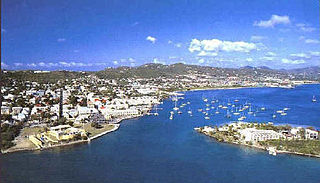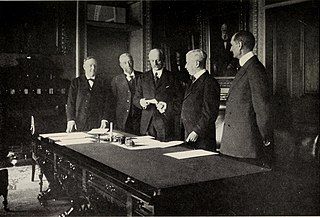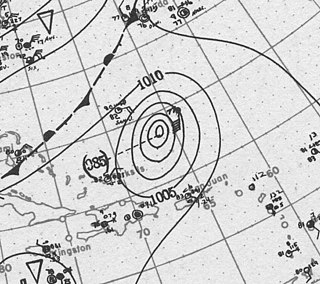Related Research Articles

The United States Virgin Islands, officially the Virgin Islands of the United States, are a group of Caribbean islands and an unincorporated and organized territory of the United States. The islands are geographically part of the Virgin Islands archipelago and are located in the Leeward Islands of the Lesser Antilles.

The Danish West Indies or Danish Virgin Islands or Danish Antilles were a Danish colony in the Caribbean, consisting of the islands of Saint Thomas with 32 square miles (83 km2); Saint John with 19 square miles (49 km2); and Saint Croix with 84 square miles (220 km2). The islands have belonged to the United States as the Virgin Islands since they were purchased in 1917. Water Island was part of the Danish West Indies until 1905, when the Danish state sold it to the East Asiatic Company, a private shipping company.

Charlotte Amalie, located on St. Thomas, is the capital and the largest city of the United States Virgin Islands. It was founded in 1666 as Taphus. In 1691, the town was renamed to Charlotte Amalie after the Danish queen Charlotte Amalie of Hesse-Kassel (1650–1714). It has a deep-water harbor that was once a haven for pirates and is now one of the busiest ports of call for cruise ships in the Caribbean, with about 1.5 million-plus cruise ship passengers landing there annually. Protected by Hassel Island, the harbor has docking and fueling facilities, machine shops, and shipyards and was a U.S. submarine base until 1966. The Town has been inhabited for centuries. When Christopher Columbus arrived in 1493, the area was inhabited by Caribs, Arawaks, Ciboney and Taíno native peoples. It is on the southern shore at the head of Saint Thomas Harbor. In 2010 the City had a population of 18,481, which makes it the largest city in the Virgin Islands Archipelago. Hundreds of ferries and yachts pass by the Town each week.
Saint Croix is an island in the Caribbean Sea, and a county and constituent district of the United States Virgin Islands (USVI), an unincorporated territory of the United States.

Danish overseas colonies and Dano-Norwegian colonies were the colonies that Denmark–Norway possessed from 1536 until 1953. At its apex, the colonies spanned four continents: Africa, Asia, Europe, and North America.

Christiansted is the largest town on Saint Croix, one of the main islands composing the United States Virgin Islands, a territory of the United States of America. The town is named after King Christian VI of Denmark.

Christiansted National Historic Site commemorates urban colonial development of the Virgin Islands. It features 18th- and 19th-century structures in the heart of Christiansted, the capital of the former Danish West Indies on St. Croix Island.

The United States Virgin Islands, often abbreviated USVI, are a group of islands and cays located in the Lesser Antilles of the Eastern Caribbean, consisting of three main islands and fifty smaller islets and cays. Like many of their Caribbean neighbors, the history of the islands is characterized by native Amerindian settlement, European colonization, and the Atlantic slave trade.

The Legislature of the Virgin Islands is the territorial legislature of the United States Virgin Islands. The legislative branch of the unincorporated U.S. territory is unicameral, with a single house consisting of 15 senators, elected to two-year terms without term limits. The legislature meets in Charlotte Amalie on the island of St. Thomas.

The West Indies is a subregion of North America, surrounded by the North Atlantic Ocean and the Caribbean Sea, which comprises 13 independent island countries and 19 dependencies in three archipelagos: the Greater Antilles, the Lesser Antilles, and the Lucayan Archipelago.

Transfer Day is a holiday celebrated in the U.S. Virgin Islands on March 31. It marks the transfer of the islands from Denmark to the United States that took place in 1917. The islands were initially held by various European countries, and were under the sole control of Denmark by 1754. Transfer Day could have taken place years earlier, but due to the construction and funding of the Panama Canal, the United States Senate rejected negotiations. Following money shortages from war, and the potential German invasion of Denmark, both sides saw the exchange as mutually beneficial. Transfer Day is now celebrated in a variety of ways on the various islands including parades, parties, and reenactment of the original Transfer Day itself.

The Episcopal Diocese of the Virgin Islands is a diocese of the Episcopal Church in the United States of America (ECUSA/T.E.C) which includes both the United States Virgin Islands and the British Virgin Islands. The diocese is a part of Province II of the Episcopal Church. The previous Diocesan Bishop of the Virgin Islands was Edward Ambrose Gumbs, the seat is currently vacant but Rafael Morales from the Episcopal Diocese of Puerto Rico serves as Bishop Advisor. The cathedral church of the diocese is the Cathedral Church of All Saints, Charlotte Amalie. The diocese currently comprises 14 churches. There is a functioning parish school on St. Thomas All Saints Cathedral School there was an academic campus on St. Croix, St. Dunstan's Episcopal High School. St. Dunstan's closed in the 1990s. There is also the St. Georges School located on the parish property of St. Georges Episcopal Church in Road Town, Tortola in the British Virgin Islands, which also opened the St. Georges School in Palestina Estate near to the St. Paul's Episcopal Church in Sea Cow's Bay, Tortola in the British Virgin Islands. There is also the St. Mary's School located on the parish property of the St. Mary's Episcopal Church in Valley, Virgin Gorda in the British Virgin Islands.

The following outline is provided as an overview of and topical guide to the United States Virgin Islands:

The following is an alphabetical list of articles related to the territory of the United States Virgin Islands.

Sugar production in the United States Virgin Islands was an important part of the economy of the United States Virgin Islands for over two hundred years. Long before the islands became part of the United States in 1917, the islands, in particular the island of Saint Croix, was exploited by the Danish from the early 18th century and by 1800 over 30,000 acres were under cultivation, earning Saint Croix a reputation as the "Garden of the West Indies". Since the closing of the last sugar factory on Saint Croix in 1966, the industry has become only a memory.

The Treaty of the Danish West Indies, officially the Convention between the United States and Denmark for cession of the Danish West Indies, was a 1916 treaty transferring sovereignty of the Virgin Islands in the Danish West Indies from Denmark to the United States in exchange for a sum of US$25,000,000 in gold. It is one of the most recent permanent expansions of United States territory.

The 1916 Virgin Islands hurricane was a strong tropical cyclone that inflicted extensive damage across the Virgin Islands in October 1916. It was the region's most destructive storm since at least the 1867 San Narciso hurricane; Consul General Christopher Payne and archaeologist Theodoor de Booy considered the 1916 storm as the archipelago's most damaging. Its peak intensity was equivalent to a Category 3 on the modern Saffir–Simpson scale. The storm began as a tropical depression southeast of Barbados on October 6, though little is known about the storm's origins or its developing stages; by the time its center was first located, the cyclone was already a hurricane and causing damage in the Virgin Islands. After forming, the storm moved northwest into the eastern Caribbean Sea and strengthened quickly. Rough seas were produced in the Windward Islands at Dominica and Saint Kitts as the storm passed nearby between October 7–8, damaging coastal villages.
The United States Virgin Islands are a group of around 90 islands, islets, and cays in the Caribbean region in which inhabitants were claimed by Spain in 1493. No permanent settlements occurred in the Spanish period and the islands were colonized by Denmark in 1671. The inhabitants remained Danish nationals until 1917. From that date, islanders have derived their nationality from the United States. Nationality is the legal means in which inhabitants acquire formal membership in a nation without regard to its governance type. In addition to being United States' nationals, Virgin Islanders are both citizens of the United States and [local] citizens of the Virgin Islands. Citizenship is the relationship between the government and the governed, the rights and obligations that each owes the other, once one has become a member of a nation.
References
- ↑ "CIA – The World Factbook – US Virgin Islands". November 10, 2021. Archived from the original on January 13, 2021. Retrieved January 24, 2021.